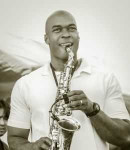Our music lesson students will have the opportunity to take lessons from the comfort of their own home or in one of the teachers studios. Careful attention is placed on each student to ensure a custom lesson plan. Our music teachers understand that every student has different needs and abilities and therefore the lessons will be planned with that knowledge in mind.
lessons are available in the following areas:
Featured Saxophone Teachers In Iberville County, LA

Geoffrey W
Instruments: Saxophone, Recorder
I am an instructor whose own passion and personal relationship with music allows for a one-of-a-kind student-teacher experience. I attended Loyola University New Orleans as a Jazz Studies major from 2008-2011, taking a 3 year sabbatical to perform and tour with the two bands I co-founded. Both of these groups commanded a prolific performance load in and around the greater New Orleans area and surrounding cities and states. In 2017, after returning to Loyola, I became the premiere graduate of the new Bachelor of Science in Popular and Commercial Music program, where I received my knowledge of the business side of the music industry, all the while never ceasing my musical performance. Read More

Max W
Instruments: Piano, Voice, Saxophone
I like to create my own lesson plans and materials, though if the student (or their parent) would like a specific method, I would be happy to oblige. For beginner, I start with the fundamentals of reading music: reading note names in different registers, reading rhythms (I like to use the Eastman system for speaking rhythms), and sight-reading skills using movable do solfeggio (all this in a manner that suits the student, whether a child or an adult. Read More

Daniel H
Instruments: Piano, Guitar, Voice, Saxophone, Harmonica, Music, Keyboard, Electric Guitar, Acoustic Guitar
I have had the pleasure of teaching several other students along the way, as I pursue my own music career, recording albums and playing tours. My students have told me that my lessons are always fun while still being challenging, which I think is as it should be. I will have you playing songs in no time, and then I will start pushing you to get to the next level! Read More

Seth B
Instruments: Guitar, Saxophone, Drums, Bass Guitar, Mandolin, Acoustic Guitar
Because every student has different levels of experiences, aptitudes, and learning styles, my teaching methods vary based on each student. Generally, I work with the student to come up with a set of goals to work towards achieving. I teach the fundamentals of the instrument through learning songs that are of interest to the student. I generally use notation (sheet music) and will use instrument workbooks if it seems appropriate, while focusing mainly on developing the ear through listening. Read More

BBB Accredited
Don't just take our word for it. We hold the highest possible A+ rating from the nations foremost online reliability source: The BBB. Check out our A+ rating from the Better Business Bureau.
